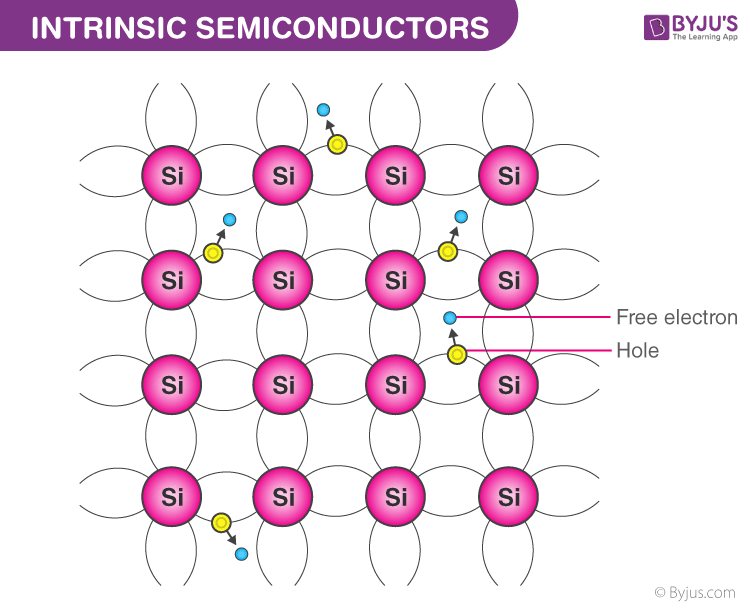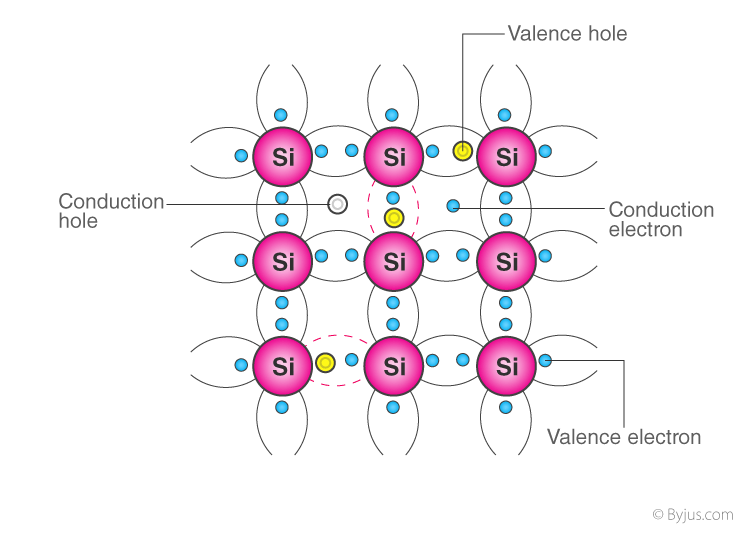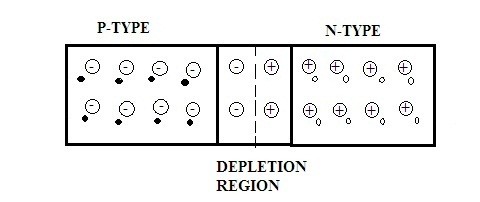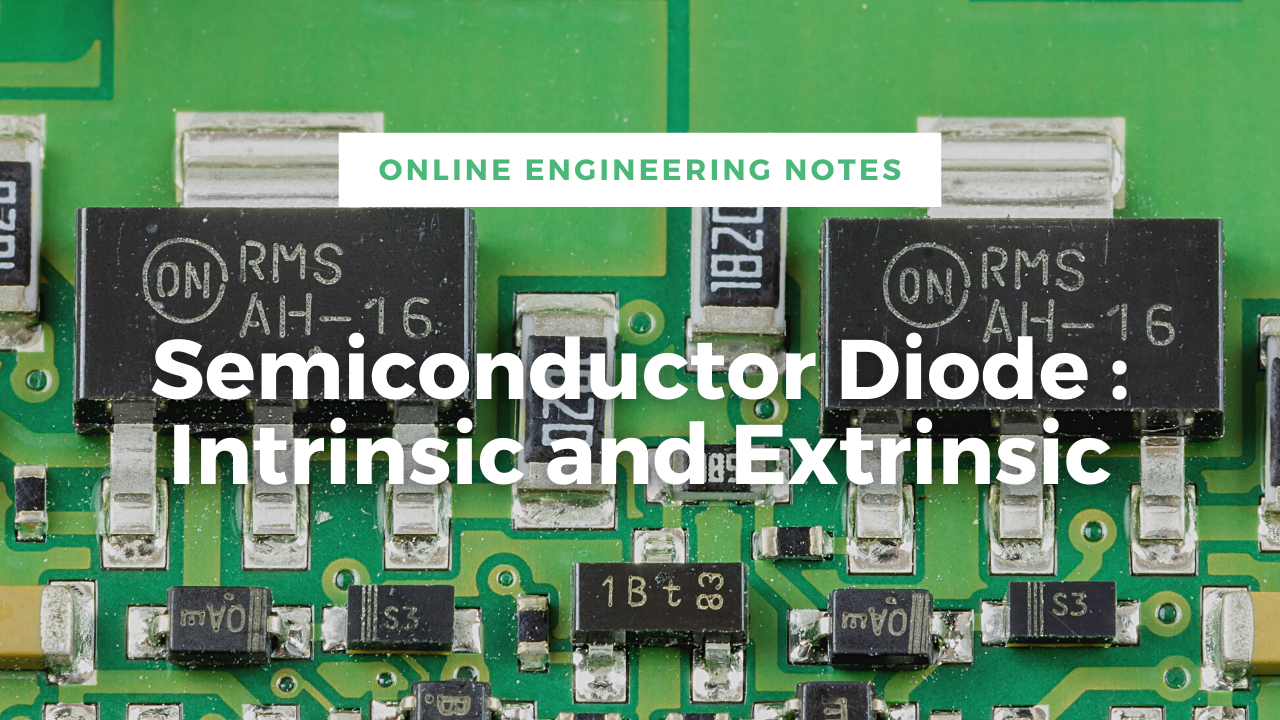Intrinsic and Extrinsic Semiconductor
Intrinsic conductor

An intrinsic semiconductor is one which is made of the semiconductor material in its extremely pure form. A semiconductor is not truly intrinsic unless its impurity content is less than one part in 100 million parts of semiconductor.
In an intrinsic semiconductor, even at room temperature, hole electron pairs are created. When electric field is applied across an intrinsic semiconductor, the current conduction takes place by two processes, namely by free electrons and holes as shown in the figure. The free electrons are produced due to the breaking up of some covalent bonds by thermal energy. At the same time, holes are created in the covalent bonds. Under the influence of electric field, conduction through the semiconductor is by both free electrons and holes. Hence, the total currents inside the semiconductor are the sum of current due to free holes and electrons.
It may be noted that current in the external wires is fully electronic i.e. by electrons. Holes being positively charged move towards the negative terminal B, electrons enter the semiconductor crystal under the terminal and combine with holes, thus cancelling them. At the same time, the loosely held electrons near the positive terminals A are attracted away from their atoms into the positive terminal, which again drift towards the negative terminals B. The electric current flows the negative terminals B. The electric current flows through the intrinsic semiconductor in the same direction as in which the holes are moving. Since, the electrons are negatively charged the direction of conventional current is opposite to that of movement of electrons. The total current inside the conductor is thus the sum of currents owing to free electrons and holes but the current in the external wires is only because of electrons.
Extrinsic conductor

A semiconductor to which an impurity at controlled rate is added to make it conductive is known as extrinsic semiconductor. The process by which an impurity is added to a semiconductor is known as doping. So, the impurity or doping material may be either pentavalent or trivalent. According to the impurity introduced, the extrinsic semiconductor can be divided into two classes, namely (i) N-type semiconductor and (ii) P-type semiconductor.
(i) N-type extrinsic semiconductors:
When a small amount of pentavalent impurity such as arsenic, antimony, bismuth or phosphorous is added to pure semiconductor crystal during the crystal growth, the resulting crystal is called the N-type extrinsic semiconductor; where N stands for negative.
When a pentavalent or a donor impurity is added to silicon or germanium the impurity atoms form covalent bonds with the silicon or germanium atoms; but since intrinsic semiconductor atoms have only four electrons and four holes in their valence shells, one spare valence shell electrons is produced for each impurity atom added. Each spare electrons so produced enters the conduction band of pure semiconductor as a free electron. The pentavalent impurity is called donor type impurity as it donates one electron to the conduction band of a pure semiconductor. Though each impurity provides only one free electron yet an extremely small amount of impurity provides enough atoms to supply millions of free electrons.
When an electric field is applied the excess electrons donated by impurity atoms move towards the positive terminal of the battery. This constitutes the electric current. This type of conductivity is called the negative or N-type conductivity because the current flows through the crystal due to free electrons (negatively charged particles).
Although N-type semiconductor has excess of electrons but it is electrically neutral. This is due to the fact the electrons are created by the addition of neutral pentavalent impurity atoms to the pure semiconductor i.e. there is no addition of either negative charges or positive charges. It is said that an N-type semiconductor has electron as majority carries and the holes as minority carriers.
(ii) P-type extrinsic semiconductor
When a small amount of trivalent impurity such as boron, gallium, indium or aluminum is added to a pure semiconductor crystal during the crystal growth, the resulting crystal is called the P-type extrinsic semiconductor; where P stands for positive.
When a trivalent impurity is added to silicon or germanium, these impurity atoms form covalent bonds with four surrounding intrinsic semiconductor atoms but one bond is left incomplete and gives rise to a hole. Such impurities make available and give rise to a hole. Such impurities make available positive carries because they create holes which can accept electrons. These impurities are consequently known as acceptor or P-type impurities. In P-type semiconductor, the majority carries are holes and minority carries are electrons.
P-type semiconductor remains electrically neutral as the number of mobile holes under all conditions remains equal to the number of acceptors. When an electric field is applied across a P-type semiconductor, the current conduction is primarily due to holes. Here, the holes are shifted from one covalent bond to another covalent bond. As the holes are positively charged, they are directed towards the negative terminal and constitute the hole current. The hole current flow more slowly than electron current in N-type semiconductor.
Different between P and N type semiconductor
| P-type semiconductor | N-type semiconductor |
| 1. It is an extrinsic semiconductor, which is obtained by doping trivalent impurity atoms such as boron, gallium indium, etc. to the pure germanium or silicon semiconductor. 2. The impurity atoms added create vacancies of electrons in the structure and are called acceptor atoms. 3. The holes are majority charge carriers and electrons are minority charge carriers. 4. In these, the impurity atom can accept one electron, hence these are known as acceptor type semiconductor. 5. In these, there is majority of positive particles and hence are known as P-type semiconductors. | 1. It is an extrinsic semiconductor, which is obtained by doping the pentavalent impurity atoms such as antinomy, phosphorous, arsenic etc. to the pure germanium or silicon semiconductor. 2. The impurity atoms added provide extra electrons in the structure and are called donor atoms. 3. The holes are minority charge carries and electrons are majority charge carriers. 4. In these, the impurity atom can donates one electron, hence these are known as donor type semiconductor. 5. In these, there is majority of negative particles and hence are known as semiconductor. |

Reference 1 : A reference book basic electronics engineering , Er. Sanjaya Chauwal, G.L Book house Pvt.Ltd.

